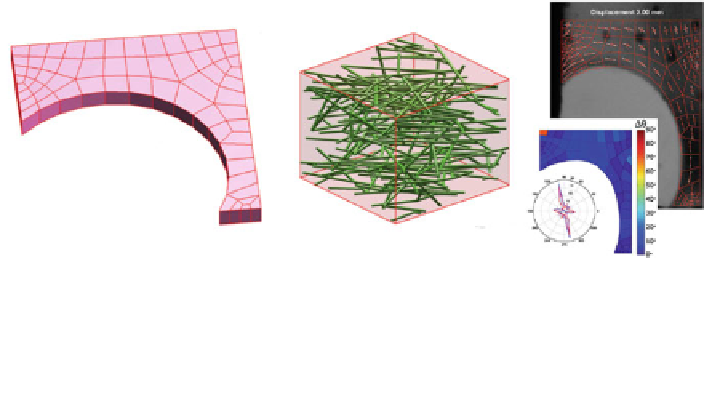Biomedical Engineering Reference
In-Depth Information
Macroscale
RVE
Validation
Fig. 13 FE
2
simulation of collagen gel mechanics [
195
]. A quarter symmetric macroscale FE
model was created of the cruciform gel sample (left). The RVE for the simulations consisted of
beam elements with a specified angular distribution (middle). Models were validated using
polarimetric fiber alignment imaging, which yielded fiber alignment vectors and contour plots of
the principle angle of the fiber alignment (right). Figure adapted from [
195
]
template for how first order FE
2
methodologies could be applied to connective
tissues such as tendon and ligament.
5.4 Multiscale Model Validation
Validation of computational models is fundamentally important if the models are
to be interpreted in a meaningful way [
9
,
103
]. Validation of macroscale com-
putational models of ligaments and tendons consist of comparing macroscale FE
simulations to experimentally measured metrics such as joint reactions forces and
in situ tissue strains, with a number of examples being present in the literature (e.g.
[
75
,
235
]). Validation of multiscale models proceeds in a similar model, but
ideally, experimental validation would occur at each scale level simulated (e.g.,
the macroscale and microscale). In a number of the aforementioned studies,
validation of the mechanical simulations were performed at a single scale level
(e.g., at the micro level for the unit cells of the myotendinous junction [
205
], and at
the macro level for the biphasic tendon model [
137
]). To our knowledge, only one
model relevant to tendons and ligaments has been validated at two scale levels
[
195
]. This study, described in the preceding section, validated macroscale results
via stress-strain data and validated microscale results via polarametric fiber
alignment imaging.
Because of the important role validation plays in interpreting the results of
computational studies, it is desirable to develop multiscale simulation strategies
and experimental validation methods concurrently. Although macroscale valida-
tion methods have been described, microscale validation methods are still in need
of improvement and development. In order to validate microscale models, data

Search WWH ::

Custom Search